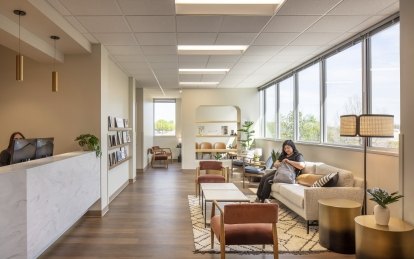Repositioning Healthcare in LA
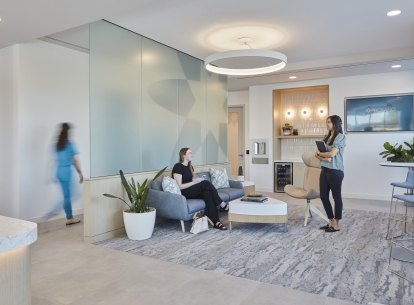
Repurposing Existing Buildings for Healthcare Spaces
Healthcare providers traditionally have relied on a new hospital building to boost patient volumes and deliver a return on investment. However, this model is no longer viable given the number of historical buildings in Southern California and the costs associated with new buildings. With rising inflation, operational challenges, and California’s escalating land and construction costs, healthcare providers are looking for alternative ways to deliver healthcare by converting underutilized, existing office buildings and retail spaces into healthcare facilities. Gerard Gulpeo explores how this trend is changing the landscape of Southern California’s healthcare system and how this will affect the built environment.
Hybrid work and online shopping are now standard practice, creating a surplus of unused real estate -- and enterprising real estate developers are turning to new avenues to lease the millions of square feet of office and retail space flooding the market in Los Angeles and surrounding counties. Meanwhile, hospitals and healthcare providers are seeking more cost-effective real estate options – resulting in more interest paid to repositioning healthcare to take advantage of existing buildings. With the number of vacancies, repurposing underutilized spaces may be the answer to finding feasible, cost-effective, and sustainable solutions to meet this demand.
Technology allows patients from different age groups to experience outpatient care in numerous provider settings that offer higher quality care, flexible choices, and more accessible and convenient locations. Healthcare systems are now looking at opportunities to repurpose existing spaces in both urban and suburban office buildings and shopping centers into Ambulatory Service Centers (ASCs), Medical Office Buildings (MOBs), and specialty clinics focused on treating specific healthcare concerns including primary care, orthopedics, cancer treatment, and GI surgery. This business strategy benefits both patients and staff by alleviating long commutes, traffic congestion, and wait times, and providing a higher level of personalized care.
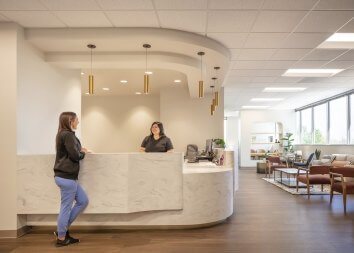
Meeting the demand for affordable medical and crisis care
Widespread disease outbreaks and natural disasters have overwhelmed healthcare systems, and spaces on hospital campuses are more efficiently utilized for inpatient care treatment. Additionally, outpatient care is best offered off campus to separate potentially infectious patients from inpatient patients. This also creates a level of financial resiliency in healthcare systems in times of pandemics.
Rehabilitation centers, behavioral health facilities, assisted living, and nursing facilities are feeling the strain as well and need to find alternative solutions. A prime example of repurposing a healthcare space is the LA County General Hospital which has stood vacant for over a decade and is now asking developers to come up with ideas to turn the campus into community beneficial spaces that allow the county to meet the demands of a growing population while simultaneously caring for those in need and training the future generation to prepare for highly skilled programs. 1
A recent report from the NAIOP Research Foundation predicts that office vacancy rates and the demand for medical space offer both healthcare systems and real estate developers some viable solutions. The report states, “Although it is difficult to estimate the amount of office space that will become available as long term leases expire in the years ahead, there will probably be an excess supply of office buildings in most markets, leaving the potential for older and empty office space to be converted into uses that are in greater demand, creating a best case scenario for office owners and developers as well as [medical] sectors that need space.” 2
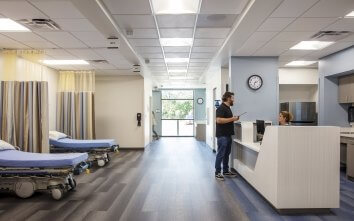
Cost savings and sustainability
Converting existing buildings into healthcare facilities is somewhat unchartered territory. Corgan and Hugo are currently conducting feasibility studies and researching multiple alternatives for aligning location and business strategy for the changing workplace and healthcare sectors.
These studies have revealed numerous benefits for choosing a conversion over new construction indicated by a few of these findings:
- Permits and other approvals are easier to obtain when repurposing existing spaces over ground-up construction and medical office uses are usually permitted in an office building’s current zoning.
- Conversions can be completed more quickly, and with the prohibitive costs of labor and materials in California, renovations are substantially less than new construction, especially in the demolition of an existing building, which can often add time and cost.
- Conversion projects are more environmentally friendly and use fewer carbon-intensive building materials than most new construction.
- A property-converted reuse space may offer a viable way to meet market demand while mitigating greenhouse emissions.
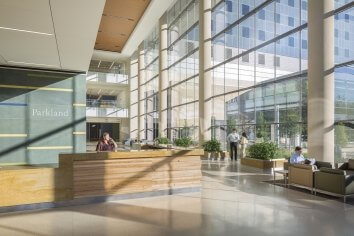
Weighing the costs and benefits of repurposing space
Title 24 regulated by HCAI (formerly called OSHPD) in California has specific requirements for healthcare facilities. OSHPD 1 and 2 spaces requires a higher level of criteria for the skin, core, and shell for seismic structural requirements. Reconfiguring the MEP and internal spaces before moving into a building adds another layer of complexity. Bringing an existing building up to code may be costly and require rerouting utilities to the roof or underground, beefing up foundations, building on top of existing structures, and doing extensive grading work for expansion or parking lots.
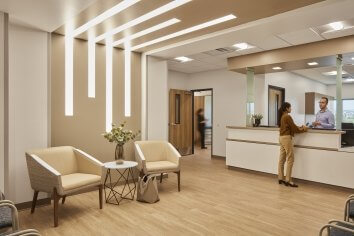
Title 24 also requires facilities to support up to 72-hours of emergency supply for domestic water and septic tank usage in a natural disaster. After seeing the aftermath of Katrina and Harvey to hospital utilities and infrastructure, we learned how vital these resources are in the case of a major natural disaster whether it be a flood, fire, earthquake, hurricane, pandemic, or other crisis.
While conversions can be expensive and pose numerous challenges, as healthcare needs continue to evolve, we will continue to examine the benefits on a case-by-case basis to determine the feasibility and advantages of repositioning healthcare through repurposing space as a beneficial and practical alternative for our clients.
Sources
- LA Times Staff. “Turning General Hospital into affordable housing.” Spectrum News, Jan 5, 2023.
- “The Future of Some Office Buildings Lies in Conversion to Medical, Life Science and Multifamily Uses.” NAIOP, 2021.
